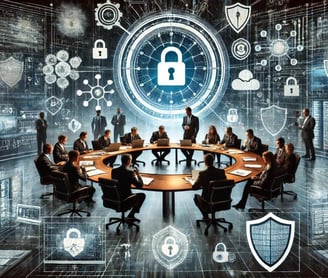From the Boardroom to the Frontlines: How Leadership Drives Cybersecurity Culture
CYBERSECURITYLEADERSHIPCULTURE


A tech company renowned for its cutting-edge innovations, experienced rapid growth as its product portfolio expanded. But with that growth came increasingly complex cybersecurity challenges. Last year, the CEO received an urgent message about a vulnerability that had been identified by a customer. Instead of leaving the issue to the incident response team, she took immediate action, convening an emergency meeting with the entire leadership team. “We’re going to experience firsthand what our teams face when the stakes are high,” she announced.
Within the hour, the entire executive team was thrown into a real-time cyberattack war room. Picture this: the CFO combing through phishing emails, the CMO troubleshooting firewall breaches, and the CTO working hand-in-hand with security engineers to identify vulnerable systems. After the event, the CEO turned to the CISO and said, “I now understand why speed and precision matter more than anything in these moments.”
This eye-opening experience led to a company-wide transformation. At the next all-hands meeting, the CEO shared a powerful message: “Security is everyone’s responsibility, and it starts with us.” She unveiled Project Shield, a bold initiative aimed at overhauling the company’s cybersecurity posture. But she didn’t just stop at announcements. The CEO herself attended cybersecurity training alongside employees, learnt about phishing attacks, the importance of multifactor authentication, incident reporting and other aspects of security hygiene. Her commitment sent a strong signal: if the CEO could prioritize security, so could every employee.
To engage the workforce, the company launched an interactive training platform featuring gamified modules. Employees earned badges for completing challenges, and top performers were celebrated in company newsletters. Six months into Project Shield, the company hosted a Security Day event, where the CEO took the stage to recognize teams that had excelled in security measures. The highlight was a surprise award for an intern who had identified a critical vulnerability during her first week on the job.
This initiative didn’t just strengthen the company’s cybersecurity defenses; it fostered a culture where every employee felt empowered to contribute to security efforts. The company became a magnet for top talent and earned heightened trust from its customers.
As you may have guessed, this story is made up, but it’s not far from reality. When a serious breach or imminent threat looms, that’s often when CEOs realize just how critical security is and that’s when they take decisive action.
Key Takeaways:
Action speaks louder than words: Leadership’s hands-on involvement drives cultural change. When executives actively participate in security exercises, it sends a clear message, security is everyone’s responsibility.
Real-time learning: Experiencing a war room situation firsthand reveals the importance of split-second decisions, leading to immediate investments in cutting-edge defenses.
Engaging training works: Gamified, interactive training makes learning about security engaging, while recognition and rewards help motivate employees to prioritize cybersecurity.
Security is everyone’s responsibility: Security isn’t just for tech team. Every department, every leader, and every employee plays a role in protecting the company from evolving cyber threats. A diverse team approach ensures comprehensive security coverage.
To wrap up, this story serves as a reminder that cybersecurity isn’t just a technical issue, it’s a company-wide priority, driven by leadership and embraced by every employee. From the executive team to new interns, everyone plays a critical role in protecting a company's assets, data, and reputation. The journey to building a strong security culture requires leadership to lead by example, continuous learning, and engaging every individual across the organization.
So what do you think? How has your organization’s leadership demonstrated commitment to security? Have you seen any innovative approaches that help foster a security-first mindset? I’d love to hear your thoughts and experiences in the comments!
